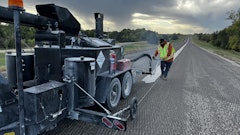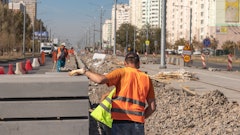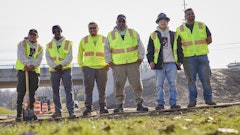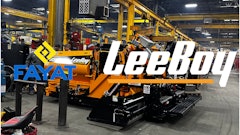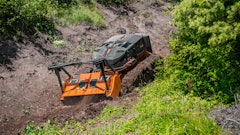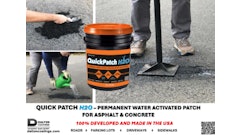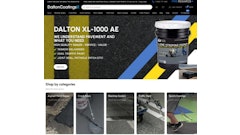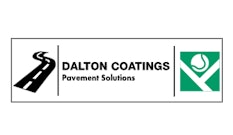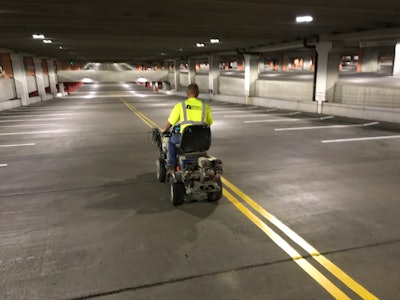
Asphalt Associates had never done work for Mall of America in Minneapolis, so when Brian Hess walked into the mall office in 2015 on a cold call, to ask who handles their striping issues, he didn’t know what to expect. After all, Asphalt Associates, Roberts, WI, had been doing its own striping for only five years.
“We added striping five years ago when we hired Bill Halbach as our operations manager and tasked him with setting up a striping division,” Hess says. “We wanted to do our own striping to deliver better and to provide a more consistent customer experience and timeline. It’s more efficient to stripe right behind the paving crew and from a scheduling standpoint.”
Hess, Asphalt Associates sales manager, says his cold call at Mall of America generated an introductory meeting followed by a second meeting. He says he asked what challenges the mall anticipated getting the job done.
“They said the biggest challenges they expected were the same challenges they face working with any contractor: a lack of communication, poor response times, and making sure contractors do the things they say they’re going to do,” Hess says. “So my sales presentation and entire approach addressed those issues. I presented him with solutions and strategies to take care of those concerns.”
Hess walked the site on his own and again with the decision-maker, and he also brought along Halbach and the three of them walked the site.
“After we had the job we asked him ‘why us?’ and he said no one was on site multiple times like I was. He also liked that I brought Bill with us so he could get to know the person who was actually going to run the job,” Hess says. “Bill’s completed plenty of large striping projects in the past and he realized that after meeting with Bill we could handle this job. Knowing Bill had the knowledge and experience of doing a lot of Big Box store jobs gave him the confidence that we could do the job.”
The Numbers on the Job
The Mall of America job was extensive, and when Hess walked it he soon learned how extensive it was. The 368,000-sq.-ft. property has two 7-story parking garages, one on each side of the mall. Asphalt Associates worked on floors one through six in each garage. The job included restriping:
· 18,000 parking stalls
· Double yellow lines through all the garage “speed ramps” that connect each of the seven floors
· Double yellow centerlines and white dashed lane lines on the 3-lane, 1-mile ring road
· Turn arrows and Stop bars
· 450 No Parking stencils
· 207 handicap stencils
· Electric charging stations (green paint)
· 1-1/2 miles of red Fire Lane curbing
· Yellow curbing
In all, Hess says, the contractor put down more than 75 miles of 4-inch lines.
In addition, the job required removal of “sticker” turn arrows on the ring road and removal of all the painted crosswalks inside and outside the garages.
“The sticker arrows were in bad shape,” Halbach says. “Snow plows tore them up and they got torn up from drivers turning on them in warm weather.” He says that using a propane torch and an ice scraper the arrows peeled right up.
Crosswalks inside steer people to elevators and stairwells. Each measures 8 ft. wide x 250 ft. long, with cross-hatched stripes every 3 ft. (a total of 1,500 lineal feet of marking for each crosswalk). Hess says there are three crosswalks per floor for a total of 36 crosswalks – or 60,000 lineal feet of removal.
Outside crosswalks were 3 ft. x 5 ft. solid blocks of paint. All that paint had to be removed and new layouts created for traditional crosswalks with cross hatching. Halbach says the outside crosswalks were removed to enable pedestrians to step on pavement as opposed to stepping on paint and also to make the entire painting project uniform.
“I gave him every stall count, linear count, stall and stencil count per floor,” Hess says. “He was surprised at that because no one had ever given that to them, but it helped create transparency and trust. We’re constantly trying to create a transparent and trusting relationship.”
Hess also assured mall management that there would be no communication issues. Asphalt Associates presented the job plan, and Halbach updated the plan status daily, sending an email to mall management. “The night before we started I let them know where we were going to be working and what we would be doing. Then the next morning, and each morning during the job, I emailed a status update letting them know if we completed 100% or 90% of the plan or whatever it was and outlining what we would be doing the next night,” Halbach says.
Tackling the Job
After spending three days walking the site, measuring lines and counting stencils, Hess spent two days developing the plan for the job. He scheduled the job for a five-person crew working on one floor of the garage each night.
Three people were charged with marking removal and two people were striping. Stalls were being striped while markings were removed, and as soon as scarifying was done and the crosswalks were laid out those were striped too. Other than the grinding and sweeping to remove the old crosswalk markings and debris, no surface preparation was required.
As with many jobs, staging the work was important but because this was a parking garage, with low ceilings, Asphalt Associates couldn’t take any of their large trucks into either structure. So they staged the equipment, paint and tools outside the ramps in surface lots.
Even though Asphalt Associates had been striping for five years they’d never done marking removal -- but Halbach had. So the contractor bought three pieces of equipment just for this job: a Graco 390 GrindLazer and two 8-inch Echo walk-behind scarifiers. Each piece of equipment was supported by a Graco LineDriver, which Halbach says made their one-floor-a-night schedule possible.
He says they relied on a Bobcat Toolcat to haul paint, tools and stencils up and down the ramps to the floors where they were needed. And the Toolcat was outfitted with a box broom to sweep the pavement after grinding was done and then haul the debris to the ground level. Sometimes the stripers had to get material from the staging area themselves, which is where the LineDrivers came in especially handy.
One of the first steps Asphalt Associates took was restriping the double yellow lines on all the speed ramps. The crew completed that on all six floors in one night so they wouldn’t have to work around wet paint to get to the staging area and so they wouldn’t have to change colors.
Though more expensive and not part of the Mall of American specifications, Asphalt Associates opted for chlorinated rubber paint throughout the job. “It wasn’t part of their standard but it offers much greater efficiency for our crew,” Hess says. “It’s a little more expensive but we can make that up in production.”
Once all the floors inside the garages were done Asphalt Associates switched gears and did the outside roadway.
Striping Removal
A major part of the job was removal of crosswalks that Hess says had 24 years of accumulated paint and was more than ¼-inch thick in some areas. Asphalt Associates’ willingness to remove the markings was one reason they got the job.
“Mall of America wanted one contractor do it all,” Halbach says. “Some would do removal but not striping and some would do striping but not removal. Mall of America wanted one contractor to do it all.”
Halbach says crews used the GrindLazer on the outlines of the crosswalks and the 8-inch Echo machines on areas that were difficult to reach. They removed markings gradually by making one pass in each direction and sweeping in between each pass. “You get better removal by doing passes in opposite directions,” Halbach says. “Instead of trying to grind it all off at once we set the dials for a thinner grind and then adjusted again on a second pass or a third when necessary.
“Dust is an issue when you’re grinding and we swept it up as we went,” Halbach says. “We tried a vacuum system the first night but while that was great for dust control it wouldn’t pick up the paint chips so it wasn’t that helpful.”
He adds that because the sides of the parking structures were open the crew didn’t need personal protection equipment. “There was way more paint debris than dust,” he says.
“The hardest part of removal was that the pavement wasn’t perfectly flat. There are expansion joints throughout and in some cases the caulk pushed above the surface,” Halbach says. “If the caulk was below the surface far enough we could scarify right over it.”
But if they couldn’t scarify over it they used a hammer drill with a spade bit to chisel the old paint off. “We also did that in some places where we couldn’t get the Echos in,” he says. “We had to be cautious because we didn’t want to profile or damage the concrete, but it all worked well.
“Once we took the paint off the pavement was fine, ready to stripe,” Halbach says. “We treated the crosswalks like a new layout. We double checked the measurements and snapped chalk lines and put the paint right down where the crosswalks were.”
Developing Mall of America-type Standards
Hess says that one of Asphalt Associates’ goals was to develop pavement marking standards for the mall. “There were inconsistencies throughout the striping, and that was one of the things we told them we wanted to fix,” Hess says.
“Our slogan is ‘Dedicated to Details,’ and we told them we would make the striping match the standards of the property,” Hess says. “It’s an elite location and they great take care of everything. There’s nothing in that mall that’s not perfect, so we not only striped the property but we created standards for them that didn’t exist before.”
The No Parking stencils, for example, were different throughout the facility. So Asphalt Associates asked Sherwin Williams to mix a special grey paint to match the concrete. Then they painted grey over the No Parking stencils and then went back the next night and put new No Parking stencils in place so they all matched.
Turn arrows in the garages were in even worse shape. Asphalt Associates couldn’t just restripe over existing arrows because they were all different and didn’t match any standard stencils. So they took an average of all the stencil measurements, created their own arrow stencil, then placed it on the existing arrows and striped them so they all now look the same. And they did the same for Stop bars and for arrows on the ring road.
“By doing that we create a relationship that is different. We wanted to go the extra mile to create the standard for their striping that they really want, like the standard Mall of America has in other areas,” Hess says. “Now everything matches and they have a clear plan moving forward how to do their striping.
“It’s a great feeling when you set out to do something of this magnitude and your team executes it as planned and to the customers satisfaction because unless you’ve done this property you’ve never striped anything this big unless you’ve done an airport,” Hess says.





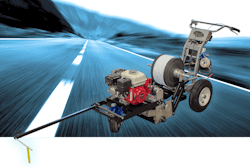
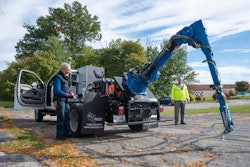
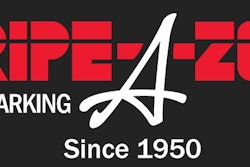
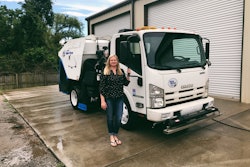
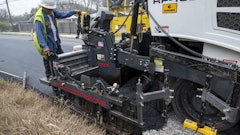
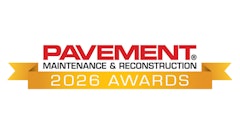
![Lee Boy Facility 2025 17 Use[16]](https://img.forconstructionpros.com/mindful/acbm/workspaces/default/uploads/2025/09/leeboy-facility-2025-17-use16.AbONDzEzbV.jpg?ar=16%3A9&auto=format%2Ccompress&fit=crop&h=135&q=70&w=240)

